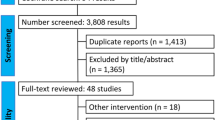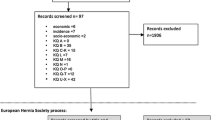Abstract
Objective
Laparoscopic totally extraperitoneal inguinal hernia repair (TEP) can be performed using either telescopic (TD) or balloon dissection (BD). The use of a disposable balloon dissector increases the cost of TEP. However, it remains unclear whether BD saves enough time to justify its cost. We hypothesized that BD would consistently save 15 min in operative time. To test this hypothesis, we designed a registry-based randomized controlled trial (RB-RCT) embedded into the Americas Hernia Society Quality Collaborative.
Methods
A single-blinded, parallel, RB-RCT was conducted. Adults with inguinal hernias presenting for elective repair were screened. Patients with unilateral hernias deemed fit to undergo TEP were eligible; those with bilateral hernias (BIH) or undergoing open repair were excluded. Individuals were randomized to TD or BD with a disposable device. TEP was performed with synthetic mesh and tacks. Subjects were blinded and followed up for 30 day. Main outcome was operative time.
Results
207 patients were screened: 166 were excluded and 41 were randomized (21 BD, 20 TD). One patient (TD group) was excluded due to the incidental finding of BIH. 40 patients were analyzed (median age 56, median BMI 26 kg/m2, 98% males). Hernias were 72% indirect, 17% direct, 10% pantaloon, and 8% recurrent. Other than obesity (26.5% vs. 0, p = 0.018), there were no baseline differences between the groups. Median operative times were similar (TD 43 min, IQR 33–63; BD 46 min, IQR 35–90, p = 0.490). There were 2 seromas and 2 hematomas in the BD group, and none in the TD (p = 0.108).
Conclusions
BD does not consistently result in 15-min time saving during TEP. Use of a disposable balloon dissector can be deferred in the experienced hands.
Trial registration
ClinicalTrials.gov (NCT03276871).

Similar content being viewed by others
References
Ferzli GS, Massad A, Albert P (1992) Extraperitoneal endoscopic inguinal hernia repair. J Laparoendosc Surg 2(6):281–286
McKernan JB (1994) Prosthetic inguinal hernia repair using a laparoscopic extraperitoneal approach. Semin Laparosc Surg 1(2):116–122
Kieturakis MJ, Nguyen DT, Vargas H, Fogarty TJ, Klein SR (1994) Balloon dissection facilitated laparoscopic extraperitoneal hernioplasty. Am J Surg 168(6):603–607 (discussion 7–8)
Al Mahroos M, Vassiliou M (2017) Laparoscopic totally extraperitoneal (TEP) inguinal hernia repair. In: Hope WW, Cobb WS, Adrales GL (eds) Textbook of hernia, 1st edn. Springer, Cham, pp 99–107
Voeller G, Brain P (2013) Technique: laparoscopic TEP. In: Jacob BP, Ramshaw BP (eds) The SAGES manual of hernia repair. Springer Science + Business Media, New York, pp 71–80
Bittner R, Arregui ME, Bisgaard T et al (2011) Guidelines for laparoscopic (TAPP) and endoscopic (TEP) treatment of inguinal Hernia [International Endohernia Society (IEHS)]. Surg Endosc 25(9):2773
Bringman S, Ek A, Haglind E et al (2001) Is a dissection balloon beneficial in totally extraperitoneal endoscopic hernioplasty (TEP)? A randomized prospective multicenter study. Surg Endosc 15(3):266–270
Misra MC, Kumar S, Bansal VK (2008) Total extraperitoneal (TEP) mesh repair of inguinal hernia in the developing world: comparison of low-cost indigenous balloon dissection versus direct telescopic dissection: a prospective randomized controlled study. Surg Endosc 22(9):1947–1958
Boutron I, Altman DG, Moher D, Schulz KF, Ravaud P (2017) CONSORT statement for randomized trials of nonpharmacologic treatments: a 2017 update and a CONSORT extension for nonpharmacologic trial abstracts. Ann Intern Med 167(1):40–47
Harris PA, Taylor R, Thielke R, Payne J, Gonzalez N, Conde JG (2009) Research electronic data capture (REDCap)—a metadata-driven methodology and workflow process for providing translational research informatics support. J Biomed Inf 42(2):377–381
Horne CM, Prabhu AS (2018) Minimally invasive approaches to inguinal hernias. Surg Clin N Am 98(3):637–649
Daes J, Felix E (2017) Critical view of the myopectineal orifice. Ann Surg 266(1):e1–e2
Putnis S, Berney CR (2012) Totally extraperitoneal repair of inguinal hernia: techniques and pitfalls of a challenging procedure. Langenbeck's Arch Surg 397(8):1343–1351
Haskins IN, Horne CM, Krpata DM et al (2018) A call for standardization of wound events reporting following ventral hernia repair. Hernia 22(5):729–736. https://doi.org/10.1007/s10029-018-1748-6
Surgical Site Infection (SSI) Event (2018) https://www.cdc.gov/nhsn/pdfs/pscmanual/9pscssicurrent.pdf. Accessed 30 May 2018
Jensen MP, McFarland CA (1993) Increasing the reliability and validity of pain intensity measurement in chronic pain patients. Pain 55(2):195–203
Muysoms F, Campanelli G, Champault GG et al (2012) EuraHS: the development of an international online platform for registration and outcome measurement of ventral abdominal wall hernia repair. Hernia 16(3):239–250
Muysoms FE, Vanlander A, Ceulemans R et al (2016) A prospective, multicenter, observational study on quality of life after laparoscopic inguinal hernia repair with ProGrip laparoscopic, self-fixating mesh according to the European Registry for Abdominal Wall Hernias Quality of Life Instrument. Surgery 160(5):1344–1357
Faul F, Erdfelder E, Buchner A, Lang AG (2009) Statistical power analyses using G*Power 3.1: tests for correlation and regression analyses. Behav Res Methods 41(4):1149–1160
The HerniaSurge Group (2018) International guidelines for groin hernia management. Hernia 22(1):1–165. https://doi.org/10.1007/s10029-017-1668-x
DeTurris SV, Cacchione RN, Mungara A, Pecoraro A, Ferzli GS (2002) Laparoscopic herniorrhaphy: beyond the learning curve. J Am Coll Surg 194(1):65–73
Neumayer LA, Gawande AA, Wang J et al (2005) Proficiency of surgeons in inguinal hernia repair: effect of experience and age. Ann Surg 242(3):344–348 (discussion 8–52)
Hynes DM, Stroupe KT, Luo P et al (2006) Cost effectiveness of laparoscopic versus open mesh hernia operation: results of a Department of Veterans Affairs randomized clinical trial. J Am Coll Surg 203(4):447–457
Lomanto D, Sta. Clara EL (2017) Total extraperitoneal (TEP) approach in inguinal hernia repair: the old and the new. In: Campanelli G (ed) Inguinal hernia surgery, updates in surgery. Springer, Paris, pp 115–129
Gholghesaei M, Langeveld HR, Veldkamp R, Bonjer HJ (2005) Costs and quality of life after endoscopic repair of inguinal hernia vs open tension-free repair: a review. Surg Endosc 19(6):816–821
Croft K, Mattingly PJ, Bosse P, Naumann RW (2017) Physician education on controllable costs significantly reduces cost of laparoscopic hysterectomy. J Minim Invasive Gynecol 24(1):62–66
Khullar OV, Fernandez FG, Perez S et al (2016) Time is money: hospital costs associated with video-assisted thoracoscopic surgery lobectomies. Ann Thorac Surg 102(3):940–947
Allen RW, Pruitt M, Taaffe KM (2016) Effect of resident involvement on operative time and operating room staffing costs. J Surg Educ 73(6):979–985
Haskins IN, Kudsi J, Hayes K, Amdur RL, Lin PP, Vaziri K (2018) The effect of resident involvement on bariatric surgical outcomes: an ACS-NSQIP analysis. J Surg Res 223:224–229
Miserez M, Alexandre JH, Campanelli G et al (2007) The European hernia society groin hernia classification: simple and easy to remember. Hernia 11(2):113–116
Acknowledgements
We acknowledge Erica Linna, RN and Jennifer Mackey, CNP for their participation on subjects follow up.
Funding
This work was funded through the Americas Hernia Society Quality Collaborative Resident/Fellow Research Grant Award.
Author information
Authors and Affiliations
Corresponding author
Ethics declarations
Conflict of interest
Luciano Tastaldi has received the AHSQC Resident/Fellow Research Grant Award that is related to this work. Aldo Fafaj has received the AHSQC Resident/Fellow Research Grant Award that is not related to the present work. David Krpata received an educational Grant from W. L. Gore not related to the present work. Ajita S. Prabhu receives personal fees from Medtronic and Intuitive Surgical Inc. and has an ongoing research Grant from Intuitive Inc. Michael Rosen received salary support for his leadership position in the AHSQC, is a board member and has stock/stock options from Ariste Medical and has ongoing research Grants from Pacira Pharmaceuticals Inc. and Intuitive Inc. Remaining authors declare no conflicts of interest.
Ethical standards
This study complies with institutional/national ethical standards and was approved by the Institutional Review Board.
Human and animal rights
All procedures performed in studies involving human participants were in accordance with the ethical standards of the Cleveland Clinic Institutional Review Board and with the 1964 Helsinki declaration and its later amendments or comparable ethical standards.
Informed consent
Informed consent was obtained from all individual participants included in the study.
Additional information
Publisher's Note
Springer Nature remains neutral with regard to jurisdictional claims in published maps and institutional affiliations.
Rights and permissions
About this article
Cite this article
Tastaldi, L., Bencsath, K., Alaedeen, D. et al. Telescopic dissection versus balloon dissection for laparoscopic totally extraperitoneal inguinal hernia repair (TEP): a registry-based randomized controlled trial. Hernia 23, 1105–1113 (2019). https://doi.org/10.1007/s10029-019-02001-y
Received:
Accepted:
Published:
Issue Date:
DOI: https://doi.org/10.1007/s10029-019-02001-y




